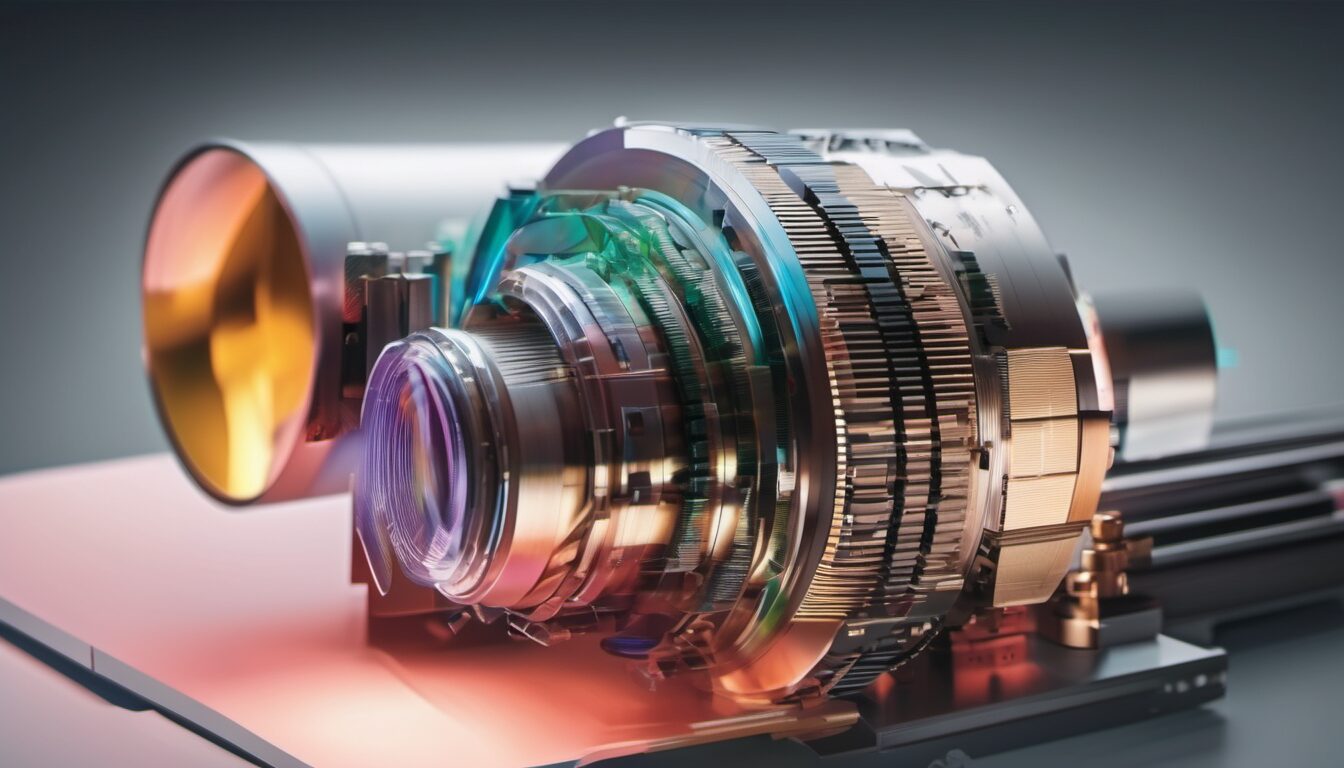Optics and photonics, the study of light and its interactions with matter, lie at the heart of many scientific and technological advancements that shape our modern world. From the development of lenses and mirrors in ancient times to the cutting-edge technologies of lasers and optical fibers today, optics and photonics have revolutionized fields as diverse as telecommunications, medicine, astronomy, and quantum computing. In this comprehensive exploration, we delve into the principles, applications, and frontiers of optics and photonics, shedding light on their profound impact on science, technology, and society.
Foundations of Optics:
The foundations of optics delve into a rich history spanning millennia, tracing its origins to the dawn of civilization. Ancient cultures like Egypt, Greece, and China embarked on an intellectual journey to comprehend the enigmatic nature of light, employing rudimentary optical tools like lenses, mirrors, and prisms. Within the annals of ancient Greece, visionary scholars ventured into realms of inquiry, formulating nascent theories concerning vision and the behavior of light, thereby laying the cornerstone for the scientific exploration of optics.
However, it was during the Renaissance period that optics ascended to a distinguished realm of scientific inquiry, propelled by the groundbreaking contributions of luminaries such as Ibn al-Haytham, Johannes Kepler, and Isaac Newton. These pioneering minds wielded a profound influence, illuminating the path towards a deeper understanding of light and vision.
Ibn al-Haytham, known as the “Father of Modern Optics,” revolutionized the field with his seminal work on the optics of vision, unraveling the mysteries of light refraction and the formation of images. Johannes Kepler’s profound insights into the nature of light paved the way for the development of modern optics, while Isaac Newton’s monumental treatise, “Opticks,” remains a cornerstone of optical theory, elucidating the principles of light dispersion and the nature of color.
Through their collective endeavors, these visionaries sculpted the foundations of optics, forging a legacy that continues to illuminate our understanding of the fundamental properties of light and its profound impact on the world around us.
The Wave-Particle Duality:
At the heart of optics lies the captivating phenomenon known as the wave-particle duality, a concept that underpins our comprehension of light’s intricate nature. This principle posits that light, at its essence, manifests both as waves and particles, its behavior oscillating between these two seemingly contrasting states contingent upon the experimental conditions.
The inception of the wave-particle duality can be traced back to the 17th century when Christiaan Huygens proposed his groundbreaking wave theory of light. Huygens’ theory elegantly explained perplexing optical phenomena such as diffraction and interference, laying a solid foundation for the understanding of light as a propagating wave.
However, the early 20th century marked a paradigm shift in the realm of optics with Albert Einstein’s seminal work on the photoelectric effect and the quantization of light. Through his revolutionary insights, Einstein elucidated the particulate nature of light, introducing the concept of photons—discrete packets of energy that behave as particles.
Today, the wave-particle duality stands as a cornerstone of modern physics, permeating our understanding of light across both macroscopic and microscopic scales. It serves as a unifying framework, bridging the gap between classical and quantum mechanics, and continues to inspire profound exploration and discovery in the realms of optics and beyond.
Geometrical Optics:
Geometrical optics constitutes a pivotal branch within the vast tapestry of optical sciences, delving into the intricate journey undertaken by light rays as they traverse through a myriad of optical apparatuses, ranging from lenses and mirrors to prisms. At its core, this discipline scrutinizes the trajectory of light along straight paths, meticulously dissecting phenomena such as reflection, refraction, and dispersion that govern its behavior.
The essence of geometrical optics lies in its ability to furnish a lucid and robust framework for comprehending the intricate interplay between light and optical elements. Through this lens, pun intended, analysts can unravel the enigmatic process through which optical systems—be it cameras, microscopes, or telescopes—conjure images.
Integral to the fabric of geometrical optics are foundational principles such as the laws of reflection and refraction, which serve as guiding beacons illuminating the path for understanding light’s behavior. Additionally, concepts like focal length emerge as linchpins in this discipline, offering insights into the convergence or divergence of light rays within optical systems.
Furthermore, the exploration of optical aberrations—deviations from ideal optical behavior—fleshes out the nuances inherent in practical optical designs, providing invaluable insights for engineers and researchers alike.
In essence, geometrical optics serves as a cornerstone in the edifice of optical sciences, offering a nuanced understanding of light’s journey through various mediums and paving the way for transformative advancements in fields ranging from astronomy to biomedical imaging.
Physical Optics:
Physical optics, often referred to as wave optics, constitutes a captivating realm within the domain of optics, delving deep into the intrinsic wave-like properties of light and its intricate interplay with matter. This branch of optics navigates through the labyrinth of phenomena arising from the interaction between light waves and obstacles, offering profound insights into phenomena such as diffraction, interference, and polarization.
At its essence, physical optics unravels the complex tapestry of light’s behavior as it traverses through space, shedding light on the subtle nuances of wave propagation. By elucidating the mechanisms behind these phenomena, physical optics lays the groundwork for the development of optical devices endowed with advanced functionalities and capabilities.
The applications of physical optics span a diverse array of fields, each benefiting from its profound insights and methodologies. Holography, a mesmerizing technique enabled by the principles of physical optics, allows for the creation of three-dimensional images with stunning clarity and depth. Spectroscopy, another cornerstone application, leverages the principles of wave optics to unravel the spectral fingerprints of materials, facilitating a myriad of scientific and industrial endeavors.
Moreover, the manipulation of light waves for information processing and communication stands as a testament to the transformative potential of physical optics. From fiber optics enabling high-speed data transmission to the development of photonic devices for quantum computing, the ramifications of physical optics reverberate across the technological landscape, shaping the contours of our modern world.
Lasers and Photonics:
The advent of lasers in the 1960s marked a watershed moment in the realms of optics and photonics, ushering in an era of unprecedented innovation and transformation. Lasers, or Light Amplification by Stimulated Emission of Radiation, manifest as powerful sources of coherent light, distinguished by their remarkable properties such as monochromaticity, directionality, and exceptional brightness.
The impact of laser technology spans a vast array of fields, where its applications have revolutionized established practices and catalyzed novel advancements. In telecommunications, lasers serve as the backbone of high-speed data transmission, enabling the seamless exchange of information across global networks with unparalleled efficiency and reliability.
Moreover, the precision and versatility of lasers find wide-ranging utility in materials processing, where they excel in tasks ranging from cutting and welding to engraving and surface modification, offering unrivaled control and efficiency in industrial processes.
In the realm of medicine, lasers have emerged as indispensable tools for a myriad of applications, including laser surgery and eye surgery, where their ability to deliver precise, minimally invasive procedures has transformed patient care and outcomes. Additionally, techniques such as laser spectroscopy facilitate precise diagnostics and therapeutic interventions, unlocking new frontiers in medical research and treatment modalities.
Beyond terrestrial applications, lasers play a pivotal role in scientific research, facilitating experiments in diverse fields such as quantum physics and atomic spectroscopy. Techniques like laser cooling of atoms have opened avenues for probing fundamental physical phenomena and advancing our understanding of the universe at its most fundamental level.
In essence, the advent of lasers and photonics represents a paradigm shift in human technological prowess, empowering us to harness the fundamental properties of light to tackle complex challenges and unlock new realms of possibility across a multitude of disciplines.
Fiber Optics and Optical Communication:
Fiber optics, the ingenious method of transmitting light through ultra-thin strands of optical fibers, stands as a revolutionary force in the realms of telecommunications and data transmission. Compared to conventional copper wires, optical fibers present a plethora of advantages, including significantly higher bandwidth, immunity to electromagnetic interference, and enhanced security measures, elevating them to indispensable status in contemporary communication networks.
At the core of modern telecommunications infrastructure, fiber optic networks serve as the backbone upon which the digital age thrives, facilitating swift and seamless data transmission across vast distances. These networks underpin critical services such as high-speed internet connectivity, enabling lightning-fast downloads, seamless streaming, and robust connectivity for millions worldwide. Furthermore, fiber optics facilitates long-distance communication, bridging geographical divides with unprecedented efficiency and reliability.
Beyond telecommunications, fiber optic technology finds application in a diverse array of fields, from optical sensing to industrial automation. Optical amplifiers, a cornerstone of optical communication systems, bolster signal strength over extended distances, ensuring data integrity and reliability. Wavelength-division multiplexing techniques enable the simultaneous transmission of multiple data streams over a single fiber, optimizing network capacity and efficiency to meet the ever-growing demands of a digital society.
Moreover, the advent of fiber-optic sensors has unlocked novel avenues for applications ranging from environmental monitoring to medical diagnostics, harnessing the intrinsic properties of light to deliver unparalleled sensitivity and precision in data acquisition.
In essence, fiber optics and optical communication represent a pinnacle of human achievement, transforming the way we connect, communicate, and interact with the world around us. As technology continues to evolve, the significance of fiber optics as an enabler of progress and innovation remains unequivocal, shaping the contours of a future defined by connectivity, efficiency, and boundless possibility.
Biophotonics and Medical Imaging:
Biophotonics emerges as a dynamic interdisciplinary domain, weaving together optical techniques and principles with the intricate tapestry of biological systems and medical diagnostics. This multifaceted field spans a vast array of applications, ranging from optical microscopy to fluorescence imaging, optical coherence tomography, and photodynamic therapy, each offering unique insights into the complexities of living organisms.
At its core, biophotonics serves as a gateway to non-invasive imaging of tissues and visualization of cellular structures, providing researchers and clinicians with unprecedented clarity and precision in their observations. Techniques such as optical coherence tomography delve into the depths of biological tissues, offering high-resolution cross-sectional images vital for diagnosing conditions ranging from retinal diseases to cardiovascular abnormalities.
Moreover, fluorescence imaging techniques illuminate the intricacies of cellular processes, enabling the detection of disease biomarkers with unparalleled sensitivity and specificity. By harnessing the unique optical properties of molecules within living systems, biophotonics sheds light on the mechanisms underlying disease progression, facilitating early detection and intervention.
Beyond diagnostics, biophotonics plays a pivotal role in therapeutic interventions, with photodynamic therapy emerging as a promising modality for targeted cancer treatment. By selectively activating photosensitive agents within tumor cells, photodynamic therapy offers a precise and minimally invasive approach to eradicating cancerous tissues while minimizing damage to healthy surrounding structures.
In essence, biophotonics stands as a beacon of innovation in the realm of medical science, offering new avenues for understanding the complexities of life and unlocking the potential for personalized medicine. As technology continues to evolve, the impact of biophotonics on medical diagnostics, drug discovery, and therapeutic interventions is poised to shape the future of healthcare, ushering in a new era of precision medicine and improved patient outcomes.
Quantum Optics and Quantum Information:
Quantum optics stands at the forefront of scientific exploration, delving into the intricate interplay between light and matter at the quantum level. Within this captivating realm, the wave-particle duality of light and the profound principles of quantum mechanics converge, shaping the behavior of photons and atoms in ways that defy classical intuition.
At its essence, quantum optics probes phenomena such as photon entanglement, quantum teleportation, and quantum cryptography, unraveling the enigmatic properties of quantum systems and paving the way for transformative applications across diverse fields.
In the realm of quantum computing, quantum optics offers tantalizing prospects for exponential increases in computational power, harnessing the inherent parallelism and superposition of quantum states to tackle complex problems with unprecedented efficiency and speed.
Moreover, quantum communication stands poised to revolutionize the landscape of secure information exchange, leveraging principles such as quantum key distribution to guarantee cryptographic security that is inherently unbreakable by classical eavesdropping methods.
Furthermore, quantum sensing emerges as a burgeoning frontier, offering unparalleled precision in the detection and measurement of physical phenomena, from gravitational waves to magnetic fields, with implications for fields as diverse as geology, medicine, and materials science.
In essence, quantum technologies harness the unique properties of quantum systems to perform tasks that are unattainable or impractical with classical technologies, promising revolutionary advances in computing power, communication security, and sensing precision. As the frontier of quantum optics continues to expand, the potential for transformative breakthroughs in science and technology remains limitless, offering a glimpse into a future shaped by the boundless possibilities of quantum information.
Frontiers of Optics and Photonics:
At the forefront of scientific exploration, optics and photonics propel humanity towards new horizons, pushing the boundaries of what we perceive as possible. Within these disciplines lie emerging fields that captivate the imagination and promise transformative breakthroughs.
Metamaterials and plasmonics stand as pillars of innovation, manipulating light at the nanoscale to unlock exotic optical properties previously unattainable. These advancements offer unprecedented control over light’s behavior, paving the way for applications in fields ranging from telecommunications to medical imaging.
Quantum photonics represents the fusion of quantum optics with photonic technologies, ushering in a new era of quantum information processing with profound implications for computing, cryptography, and beyond. Integrated photonics, meanwhile, miniaturizes optical components onto chips, revolutionizing the landscape of optical systems by enabling compact, efficient devices with multifunctional capabilities.
These cutting-edge developments hold promise across diverse domains, from computing and communications to sensing and healthcare. They represent the vanguard of scientific inquiry, poised to redefine the limits of human achievement and shape the course of technological progress for generations to come.
Optics and photonics, rooted in the ancient observations of light’s behavior, have evolved into fundamental pillars of modern civilization. They illuminate our world in ways both seen and unseen, driving innovation, fostering discovery, and inspiring awe. As we continue to unravel the mysteries of light and harness its power, we embark on a journey of exploration and enlightenment, guided by the enduring promise of optics and photonics to illuminate our path towards a brighter future.










More Stories
Securing the Cyberspace: DDoS Attacks and Botnets
Securing the Connected: Cybersecurity Strategies for IoT
Exploring the Advancements and Applications of Supercapacitor